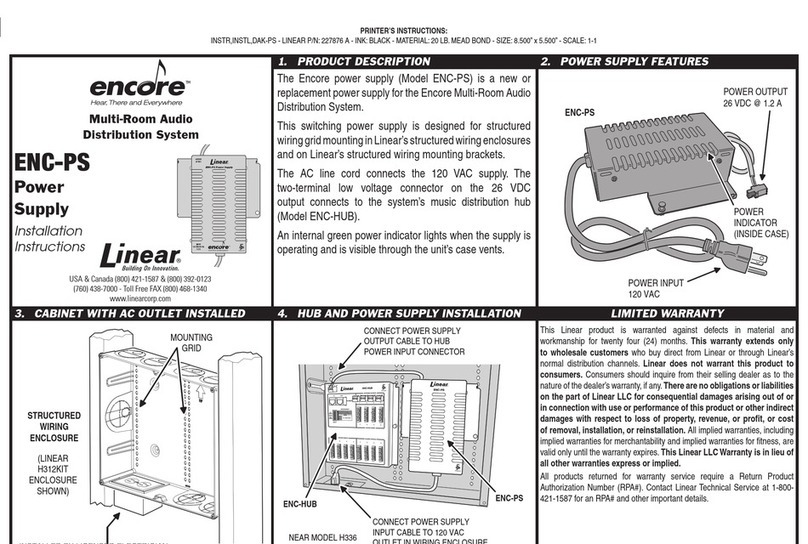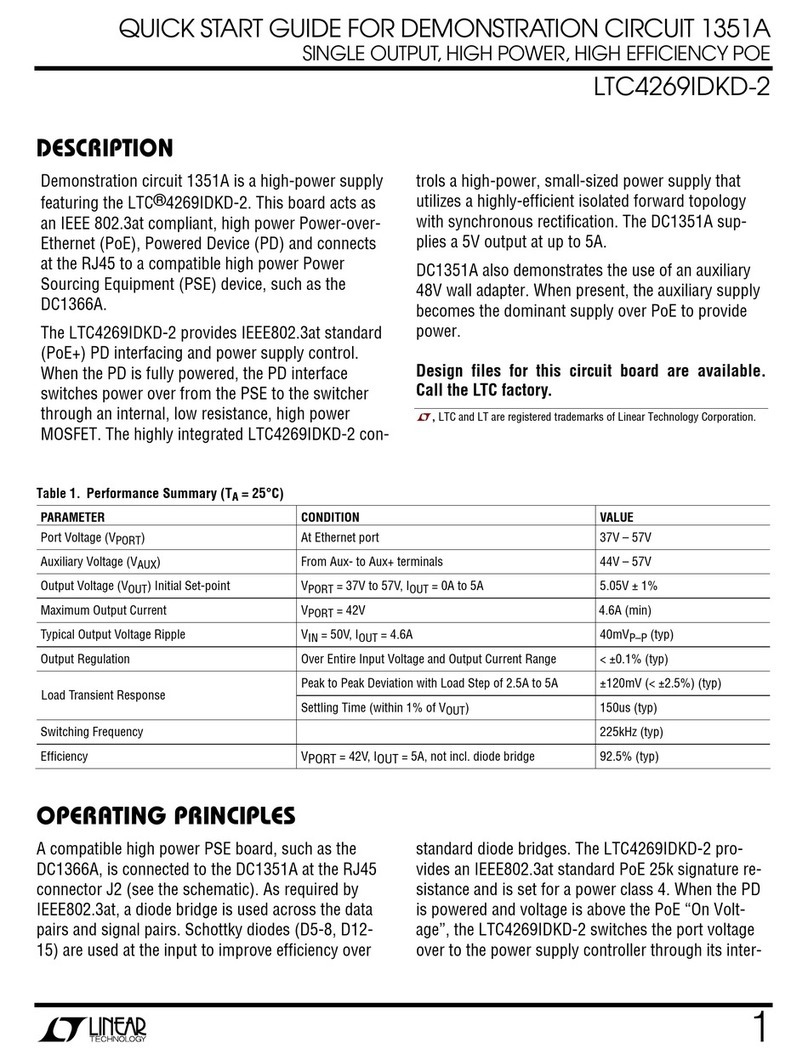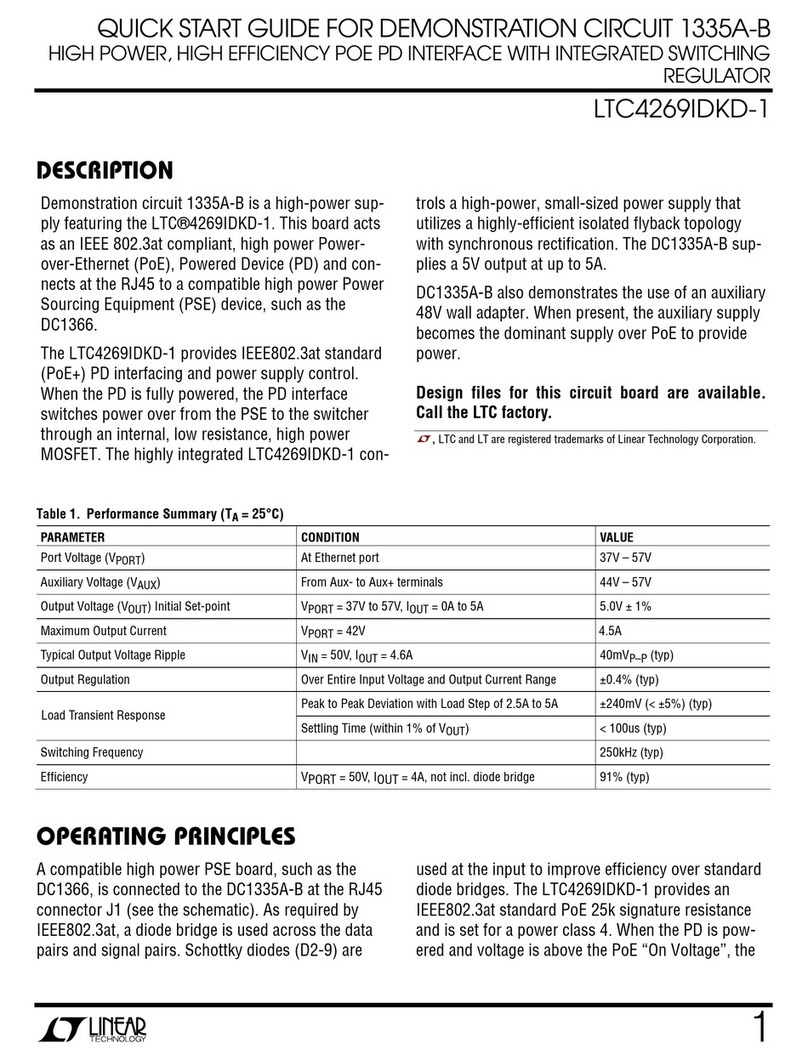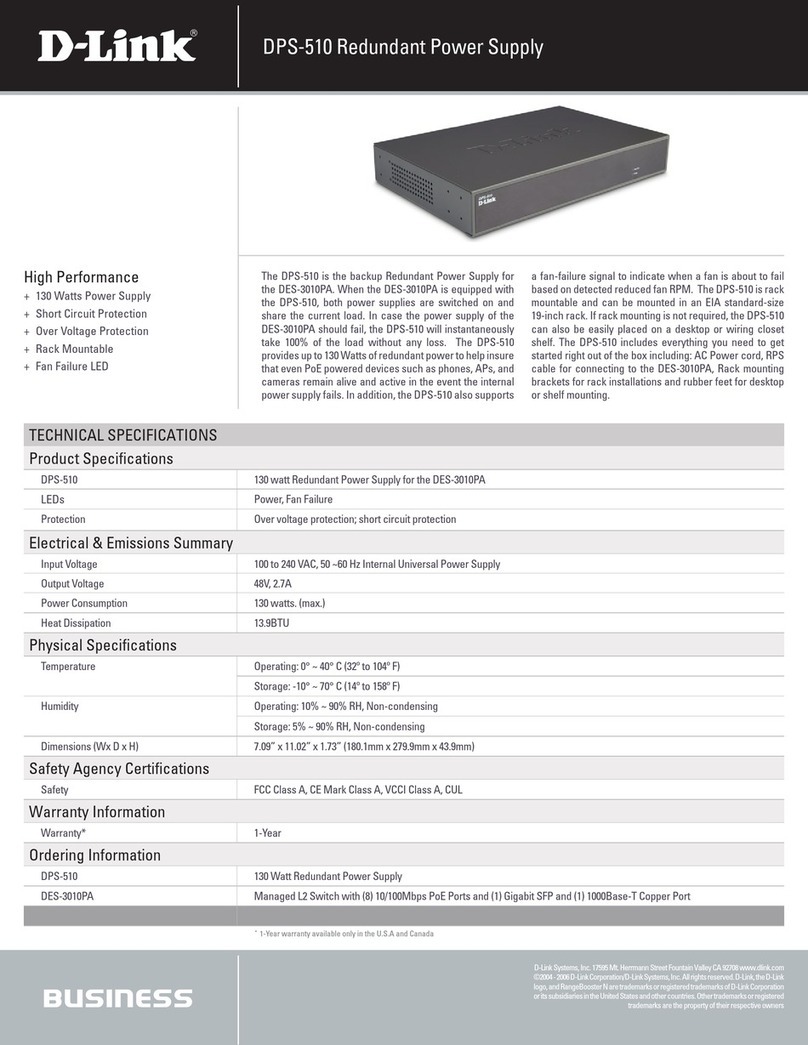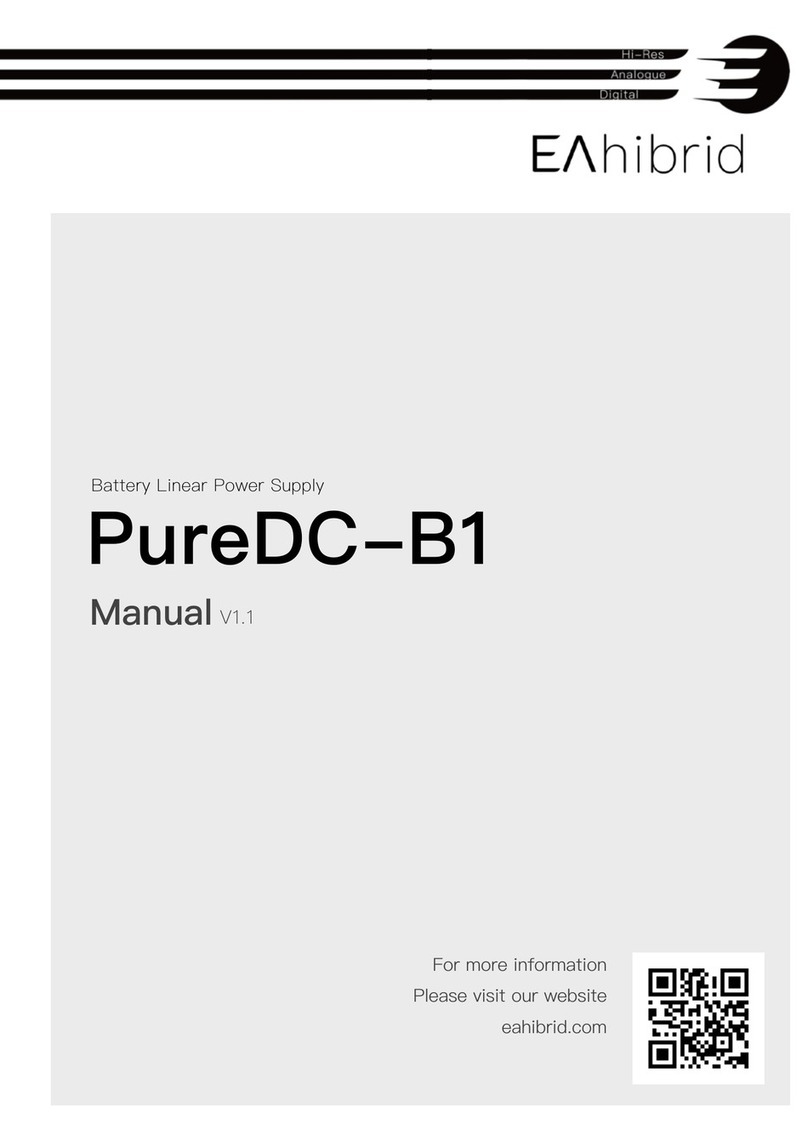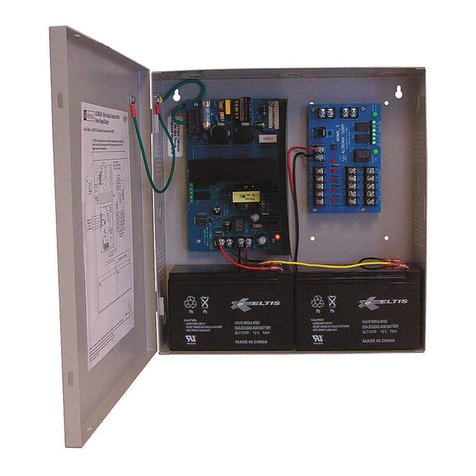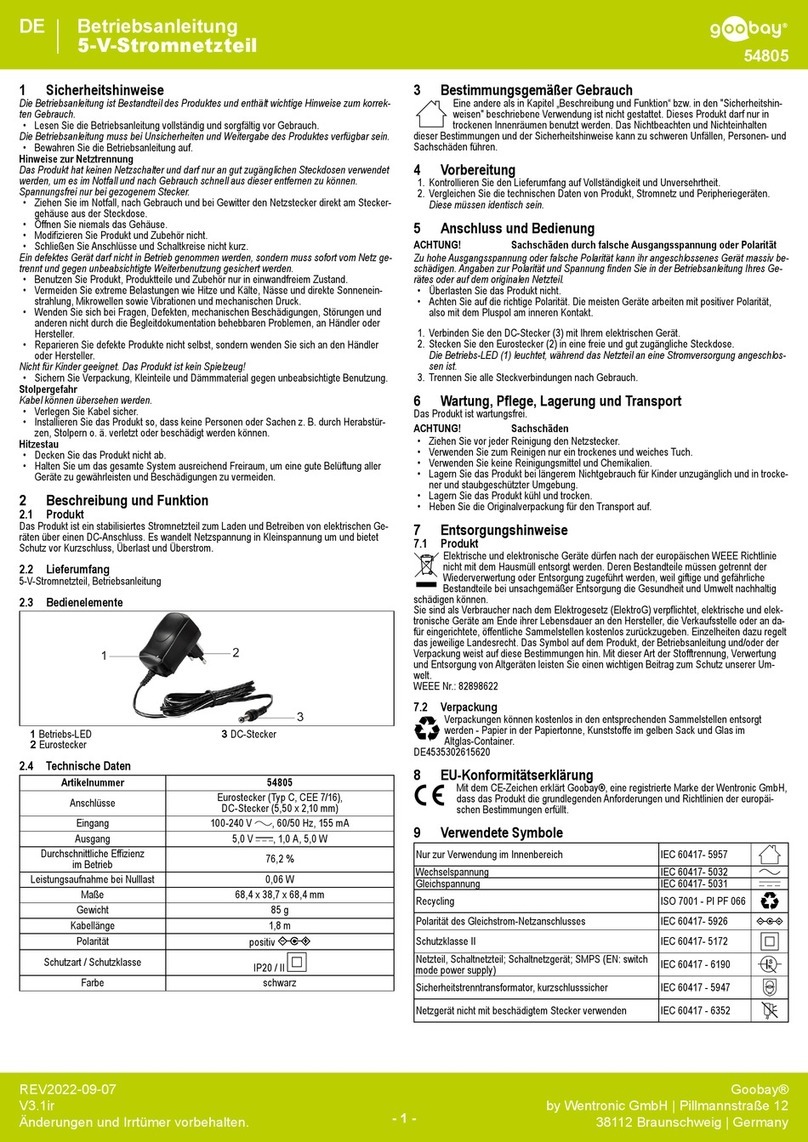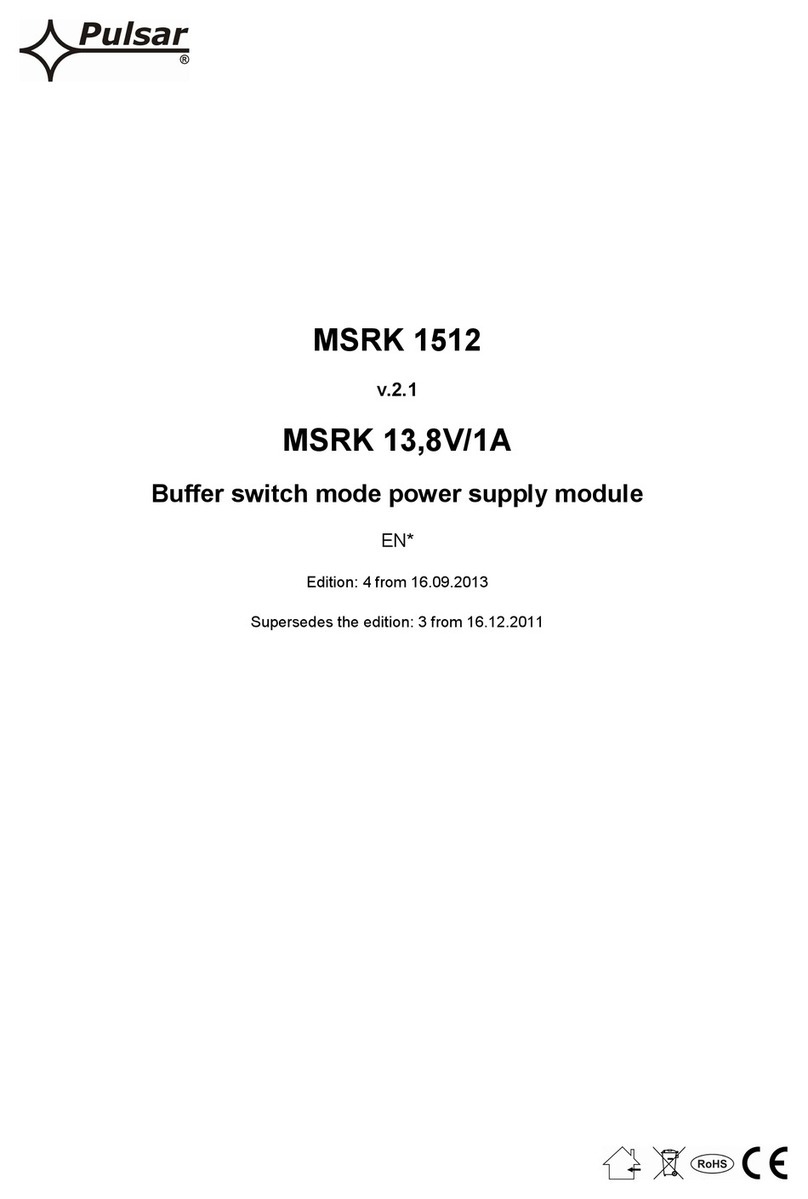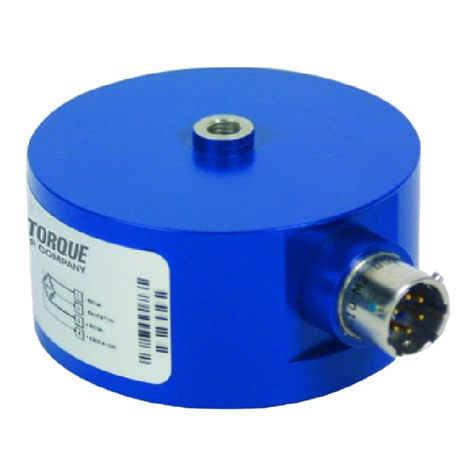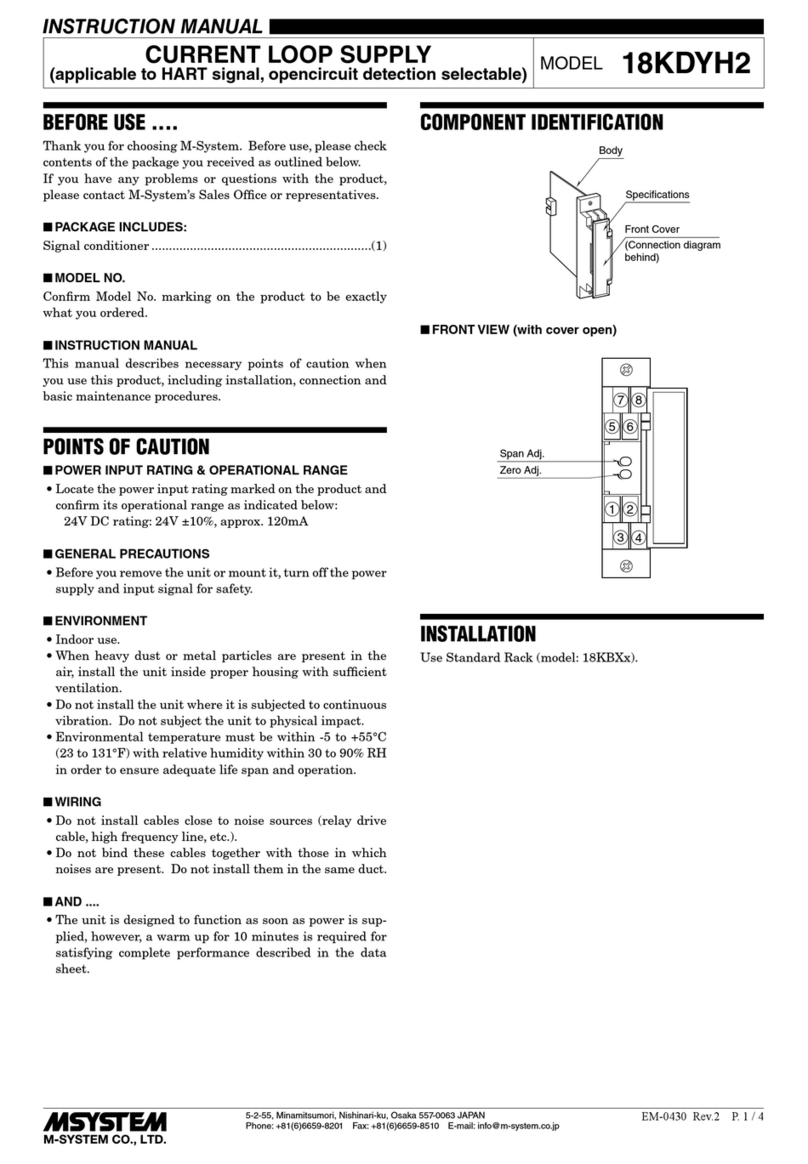Linear LTM2987 User manual

1
dc2023afa
DEMO MANUAL DC2023A
DESCRIPTION
16-Channel Power Supply
System Featuring the LTM2987
Power System Manager
TheDC2023Aisademonstration system fortheLT M
®
2987
16-channel I2C/SMBus/PMBus power system manager
with EEPROM. The LTM2987 monitors and controls 16
power supply rails. The DC2023A demonstrates the abil-
ity of the LTM2987 to sequence, trim, margin, supervise,
monitor, and log faults for 16 power supply rails. Each
power supply channel’s output voltage is monitored and
the LTM2987 monitors its own internal die temperature.
The DC2023A is a single circuit board that contains sixteen
independentpowersupplyrails.Theboard employs sixteen
LT C
®
3405A 300mA switch-mode regulators, which are
configured tobecontrolled bytheLTM2987. The LTM2987
is available in a µModule
®
(micromodule) package and
contains two LTC2977 devices. This board provides a
sophisticated 16-channel digitally programmable power
supply system. The rail voltages are programmable within
the trim range shown in the Performance Summary.
This demonstration system is supported by the
LTpowerPlay™graphical user interface(GUI) that enables
complete control of all the features of the LTM2987. To-
gether,the LTpowerPlay software and DC2023Ahardware
system create a powerful development environment for
designing and testing LTM2987 configuration settings.
These settings can be stored in the device’s internal
EEPROM or in a file. This file can later be used to order
pre-programmed devices or to program devices in a
production environment. The software displays all of
the configuration settings and real time measurements
from the LTM2987. Telemetry allows easy access and
decoding of the fault log created by the LTM2987. The
board comes pre-programmed with the EEPROM values
appropriate for the sixteen power supplies used on the
DC2023A. Just plug and play!
Multiple DC2023A board sets can be cascaded together
to form a high channel count power supply (see Multi-
Board Arrays). This cascaded configuration demonstrates
features of the LTM2987 which enable timing and fault
information to be shared across multiple ICs. The user can
L, LT, LTC, LTM, Linear Technology, the Linear logo and µModule are registered trademarks
and PowerPlay is a trademark of Linear Technology Corporation. All other trademarks are the
property of their respective owners.
configure up to eight DC2023A boards, thereby control-
ling up to 128 separate power supply rails. Larger arrays
of LTM2987s are supported through programmable I2C
base address or bus segmentation.
The DC2023A demo board can be powered by an external
power supply, such as a +12VDC supply. Communication
with the software is provided through the DC1613 USB-to-
I2C/SMBus/PMBus Controller. The following is a checklist
of items which can be obtained from the LT C website or
LT C Field Sales.
• USB-to-I2C/SMBus/PMBus Controller (DC1613)
• LTpowerPlay Software
DC2023A Features
• Sequence, Trim, Margin, and Supervise Sixteen Power
Supplies
• Manage Faults, Monitor Telemetry, and Create Fault
Logs
• PMBus Compliant Command Set
• Supported by LTpowerPlay GUI
• Margin or Trim Supplies to 0.25% Accuracy
• Fast OV/UV Supervisors Per Channel
• Supports Multi-Channel Fault Management
• Automatic Fault Logging to Internal EEPROM
• Operates Autonomously without Additional Software
• Sixteen OV/UV VOUT and Tw o VIN Supervisors
• Telemetry Reads Back VIN, VOUT, and Temperature
• 16-Channel Time-Based Output Sequencer
• I2C/SMBus Serial Interface
• IntegratedDecoupling Capacitors andPull-Up Resistors
• Powered from 6V to 14VDC
• Available in 144-Lead 15mm ×15mm BGA
Design files for this circuit board are available at
http://www.linear.com/demo

2
dc2023afa
DEMO MANUAL DC2023A
PERFORMANCE SUMMARY
GLOSSARY OF TERMS
Specifications are at TA= 25°C
POWER SUPPLY CHANNEL CH(0:7) CH(8:15)
Manager 1/2 LTM2987 1/2 LTM2987
Nominal Untrimmed Output Voltages 1.0V, 1.1V, 1.2V, 1.3V, 1.4V, 1.5V, 1.7V, 1.8V 2.0V, 2.2V, 2.5V, 2.7V, 3.0V, 3.1V, 3.2V, 3.3V
Rated Output Current 0.3A
Default Margin Range ±5%
Output Trim Range (VFS_VDAC = 1.38V) +13/–19 % +11/–15%
Temperature 2 Internal
Common Characteristics—Specifications Valid Over Full Operating Temperature Range
PARAMETER CONDITIONS
VALUE
MIN TYP MAX UNITS
Supply Input Voltage Range 6 14 V
ADC Total Unadjusted Error VIN_ADC ≥ 1V ±0.25 %
ADC Voltage Sensing Input Range Differential Voltage: VIN_ADC = (VSENSEP[n] – VSENSEM[n]) 0 6 V
The following list contain terms used throughout the
document.
Channel – The collection of functions that monitor, su-
pervise, and trim a given power supply rail.
EEPROM – Non-volatile memory (NVM) storage used to
retain data after power is removed.
Margin – Term used typically in board level testing that
increases/decreases the output voltage to look for sensi-
tivity/marginality problems
Monitor – The act of measuring voltage, current and
temperature readings.
NVM – Non-volatile memory, see EEPROM.
PMBus – An industry standard power-management proto-
col with a fully defined command language that facilitates
communication with power converters and other devices
in a power system.
Rail – The final output voltage that the power supply
controller manages.
Supervise – The act of quickly responding to a voltage,
current, temperature condition that is compared to pre-
programmed values (fault settings).
Trim – The act of adjusting the final output voltage. A
servo loop is typically used to trim the voltage.

3
dc2023afa
DEMO MANUAL DC2023A
LTpowerPlay GUI SOFTWARE
LTpowerPlay is a powerful Windows-based development
environment that supports Linear Technology Power
System Management ICs with EEPROM, including the
LTM2987 16-channel PMBus Power System Manager.
The software supports a variety of different tasks. You
can use LTpowerPlay to evaluate Linear Technology ICs
by connecting to a demo board system. LTpowerPlay can
also be used in an offline mode (with no hardware pres-
ent) in order to build a multi-chip configuration file that
can be saved and reloaded at a later time. LTpowerPlay
provides unprecedented diagnostic and debug features. It
becomes a valuable diagnostic tool during board bring-up
to program or tweak the power management scheme in
a system or to diagnose power issues when bringing up
rails. LTpowerPlay utilizes the DC1613 I2C/SMBus/PMBus
Controller to communicate with one of many potential tar-
gets, including the DC2023A demo system or a customer
board. The software also provides an automatic update
feature to keep the software current with the latest set
of device drivers and documentation. The LTpowerPlay
software can be downloaded from:
http://www.linear.com/ltpowerplay
To access technical support documents for LT C power
system management products visit Help, View Online
Help on the LTpowerPlay menu.
Figure 1. Screen Shot of the LTpowerPlay GUI

4
dc2023afa
DEMO MANUAL DC2023A
QUICK START PROCEDURE
Thefollowing proceduredescribes howto setup aDC2023A
demo system.
1. Download and install the LTpowerPlay GUI:
http://www.linear.com/ltpowerplay
2. Remove the board from the ESD protective bag
and place it on a level surface. Connect the DC1613
I2C/SMBus/PMBus Controller to the DC2023A board
using the 12-pin ribbon cable.
3. Confirm that the CONTROL switch is set to the RUN
position.
4. Plug the USB to I2C/SMBus/PMBus Controller into a
USB port on your PC. The board should power up with
all power good LEDs and +5V LED illuminated green.
The USB-to-I2C/SMBus/PMBus Controller supplies
~100mA of current which should be sufficient for a
single demo board.
5. Ifmultiple boards arebeing powered, connect a+12VDC
power supply with > 0.5A capacity to the VIN input jack
of the DC2023A.
6. Launch the LTpowerPlay GUI.
a. The GUI automatically identifies the DC2023A and
builds a system tree. The system tree on the left hand
side should look like this:
Figure 2. Connecting DC2023A board and the DC1613 I2C/SMBus/PMBus Controller
Note:For multiple board arrays, the GUI automatically
ensures each device has a unique address. In this
scenario, it isrecommended at this point to
store these addresses to NVM (EEPROM)
by clicking the “RAM to NVM” icon in the
toolbar.

5
dc2023afa
DEMO MANUAL DC2023A
QUICK START PROCEDURE
b. A green message box will be displayed for a few
seconds in the lower left hand corner confirming
that the DC2023A is communicating:
c. Save the demo board configuration to a (*.proj) file
by clicking the "Save" icon. This creates a backup
file. Name it whatever you want.
7. The CONTROL switch is configured to control all 16
channels. Slide the switch to RUN to enable, OFF to
disable all channels. For multiple board arrays, the
CONTROL switch is wired to a signal that is common
across all boards. All CONTROL switches must be set
to the RUN position to enable all boards.
Loading a DC2023A Configuration (*.Proj) File with
the GUI
1. In the upper left hand corner of the GUI, File > Open
> browse to your *.proj file. This will load the file into
the GUI.
2. Click on the “Go Online” icon, then click on the
“PC->RAM” arrow. This loads the configuration into
the working RAM of the LTM2987.
3. To store the configuration to NVM (EEPROM), click on
the “RAM->NVM” icon.
Figure 3. DC2023A Top Side Details

6
dc2023afa
DEMO MANUAL DC2023A
Margin All Rails
The LTM2987 power manager on the DC2023A not only
monitors each of the sixteen outputs but can margin the
outputs either high or low. Margining is the operation
that moves a rail either up or down for testing purposes.
It allows a system to be fully characterized over supply
limits without the use of external hardware or resources.
The GUI provides an easy way to margin all rails high
or all low by clicking one of four buttons. To invoke the
margining dialog, click the GroupOp icon in the toolbar.
The buttons labeled “ignore faults” will margin
without creating a fault even if the fault limits
are exceeded.
COMMON DEMO BOARD OPERATIONS
A look at the telemetry window shows the effect of the
margin high or margin low operation. The following screen
shot shows all rails going from nominal set points to
margin high, margin low, and back to nominal voltages.
Each LTC2977 inside the module has a multiplexed ADC
that is used to provide voltage, current, and temperature
readback values. The telemetry plot in the GUI is similar to
amulti-channel oscilloscope whichis capable of displaying
any parameter that is displayed in the telemetry window.
Due to the nature of a multiplexed ADC converter, it has
an associated ADC loop time. The total ADC loop time
(~100ms to 160ms) for a given channel is dependent on
the device’s configuration. Refer to the LTM2987 data
sheet for complete ADC timing specifications.
Creating a Fault
There is a pushbutton on the DC2023A board that is used
to force a fault and demonstrate the demo board’s ability to
detect it and respond according to the configuration. When
depressed, the pushbutton creates a fault on channel 10,
the 2.5V output (GUI channel U1:2). The user should see
all outputs power off, the fault LED momentarily illuminate,
thealert LED illuminate continuously, and all rails sequence
back on after a retry period. The user may also short any
power supply output indefinitely. This
is a good way to induce UV faults and
shows that a shorted channel will not be
damaged. Use a jumper wire or a coin
to short any output.

7
dc2023afa
DEMO MANUAL DC2023A
COMMON DEMO BOARD OPERATIONS
The LTM2987 has a feature which allows it to sequence its
channels off in a controlled manner, as opposed to turning
all rails off immediately. The SequenceOffOnFault bit in the
MFR_CONFIG_LTC2977registersets this behavior on each
channel. The DC2023A demo board has been configured
to sequence off all channels when a fault occurs. Pressing
the “CREATE FAULT” pushbutton causes the FAULT pin
to be asserted low which triggers all rails to power down
based on the TOFF_DELAY times.
Figure 5. Sequencing Off (SeqOffOnFault=0)
Figure 4 shows FAULTB asserting low, and each of the
channels sequencing off per the TOFF_DELAY settings.
Figure 5 shows the same except that the 3.0V rail (CH12)
does not have its SequenceOffOnFault bit set. The 3.0V
rail powers down immediately as defined by the fault
response setting.
Clearing a Fault
To clear a fault, the user may click the CF icon in the GUI
or simply push the RESET pushbutton on the demo board.
In both cases, the red (+) on the CF icon and alert LED
on the board will be cleared. You will notice that all rails
are automatically re-enabled after a programmable retry
period. The alert LED may be cleared by pushing the Clear
Faults (CF) icon in the GUI. After clearing faults, the system
tree may remain “yellow” if any non-volatile fault
logs are present. For further information, see the
Working with the Fault Log section.
Resetting The DC2023A
A reset pushbutton is provided on the board. To reset all
devices on the DC2023A board and reload the EEPROM
contents into operating memory (RAM), press RESET
(SW1) on the DC2023A.
DC2023A LEDs
Each individual channel on DC2023A also has its own
green “power good” LED (CH0 through CH15). When USB
power (DC1613 Controller) or external power (6-14V jack)
is applied, the +5V green LED will illuminate, indicating
that the LTM2987 is powered. The red LEDs will illuminate
when an alert or a fault has occurred.
Figure 4. Sequencing Off (SeqOffOnFault=1)

8
dc2023afa
DEMO MANUAL DC2023A
Sequencing Output Channels
The LTM2987 has been pre-programmed to different
TON_DELAY values for each channel. The TON_DELAY
parameter isapplied toeach device relative toits respective
CONTROL pin. When multiple demo boards are connected
together, all CONTROL pins are wire OR’d. Therefore the
TON delays are enforced relative to one edge. The same
applies to TOFF_DELAY values. When the CONTROL
switch is set to the OFF position, all rails will power down
sequentially based on each of the device’s TOFF_DELAY
values. Figure 6 shows an oscilloscope screen capture of
COMMON DEMO BOARD OPERATIONS
Figure 6. Sequencing Output Channels with DC2023A Using TON_DELAY and TOFF_DELAY
Figure 8. TOFF_DELAY Configuration
Figure 7. TON_DELAY Configuration
three output rails sequencing up and down in response
to the CONTROL pin.
Each channel has an LED which visually indicates if the
channel has power. When the CONTROL pin is switched
on and off, you will observe the relative on/off timing of
the 16 channels.
For the LTM2987, the TON_DELAY and TOFF_DELAY
values extend to 13.1 seconds, providing very long on
and off sequencing of power supply rails.

9
dc2023afa
DEMO MANUAL DC2023A
COMMON DEMO BOARD OPERATIONS
Figure 9. Why Am I Off Tool in the LTpowerPlay GUI
Why Am I Off? Tool
Use the Why am I Off tool in the LTpowerPlay GUI to di-
agnose the reason a power supply channel is turned off.
The tool can be located in the top right corner of the GUI,
next to the Register Information tab. Hover your cursor
over this tab to show the tool.

10
dc2023afa
DEMO MANUAL DC2023A
ADVANCED DEMO BOARD OPERATIONS
What Is a Fault Log?
A fault log is a non-volatile record of the power system
leading up to the time of fault. It holds the most recent
monitored values (up-time, voltage, current, temperature)
that can be analyzed to help determine the cause of the
fault. It is a powerful diagnostic feature of the LTM2987
on the DC2023A demo board.
Create a Fault and Fault Log
To create a fault log, you must create a fault, as described
in the Creating a Fault section. If multiple boards are
configured, select the appropriate device in the system
tree by clicking on the appropriate LTM2987 chip. We will
proceed to work with the fault log.
Working with the Fault Log
Once a fault has occurred, the Fault Log (FL) icon will show
a red (+) sign on it, indicating that the GUI has detected a
fault log in the device. Clicking the icon will bring
up a dialog box. Note that it is context sensitive.
Be sure that the desired device is selected in the
system tree.
Notice that the checkbox “Log to EEPROM on Fault” is
checked. Once a fault occurs, the device will automatically
write the fault log data to EEPROM (NVM). At this point,
the log is locked and will not change until it is cleared by
the user. To read the EEPROM log data, first click the “NVM
to RAM” button. At this point the RAM Log is locked and
not updated even though the telemetry readings continue.
Click the “Read RAM Log” button. The log data will appear
in the text box below.

11
dc2023afa
DEMO MANUAL DC2023A
ADVANCED DEMO BOARD OPERATIONS
The log contains timestamp, up-time, channel voltage
readings, an input voltage reading, an on-chip temperature
reading, etc. There will be a number of loops; each loop
contains data obtained in one ADC loop time with the
most recent ADC loop data on top and the oldest data at
the bottom of the log. The up-time indicates, at the time
of fault, the amount of time the device has been powered
up or time since the previous reset.
In this case, the fault log will show that channel U1:2
faulted due to a VOUT_UV_FAULT condition. On the pre-
vious telemetry loop, the channel voltage reading was a
nominal value (2.5V).
To clear the fault log, click the “Clear/Rearm EEPROM
Log” button. This allows the selected device to be ready
for a new fault event. To clear all faults, click the Clear
Faults (CF) icon.
Fault Sharing Setup in the GUI
Fault sharing provides a means of propagating a fault de-
tected by a power system manager to other power system
managers via FAULT pins. Use the Fault Sharing Setup
Tool to configure the fault sharing in the GUI. Select the
LTM2987 labeled U0 in the system tree. Go to Utilities >
FaultSharing Diagram.For moredetails on thistopic, please
refer to the Fault Management section in the data sheet.
The fault sharing dialog will appear as shown in Figure10.
All Response and all Propagate switches are closed by de-
fault. In this configuration, a fault on one of the LTM2987
channels will shut down all 16 channels, and a fault on any
LTM2987 channel will propagate to all channels on the
DC2023A demo board since the fault pins are tied together.
Note: All FAULT pins on the LTM2987 are tied together on
the DC2023A demo board. These pins are open drain and
have a common pull-up resistor to provide a logic high
level (inactive). All FAULT pins are active low.
There are two types of actions to fault conditions: How a
channel responds to another channel’s fault and whether
a particular channel propagates a fault to other channels.
FAULT pins are bidirectional, meaning the device may drive
its FAULT pin low (output) or may respond to the FAULT

12
dc2023afa
DEMO MANUAL DC2023A
ADVANCED DEMO BOARD OPERATIONS
pin when another device drives it low (input). Because all
FAULT pins are wire OR’d on the DC2023A, this hardware
configuration allows one to program each device’s fault
settings on a channel-by-channel basis. By default, the
LTM2987 is configured to shut down all channels if other
devices fault and to broadcast its own fault via the FAULT
pins. A fault on these channels will cause only that channel
to fault off. You can think of the “Response” switches as
“shut this channel down when another channel faults”, and
the “Propagate” switches as “drive a fault pin to broadcast
to other channels that this channel faulted”.
Fault Configuration Example
Let’s explore two different examples. Suppose we do not
want channel U0:0 (CH0 1.0V rail) to propagate its fault
to the other channels when it faults. And suppose we do
not want channel U0:1 (CH1 1.1V rail) to shut down in
response to another channel’s fault. We can configure the
switches as shown in Figure 11. Simply click the switches
to open/close. Click OK to close the dialog box. Click the
“PC->RAM” icon to write the changes to the DC2023A.
We can now create a fault on U0:0 (CH0) by shorting
the output to ground. You may use a coin or a jumper
to temporarily connect CH0 to the GND turret. You will
notice that the channel shuts off but the other channels
remain powered up because its fault is not propagated to
the other channels. After the retry period, channel U0:0
(CH0) will power back up. We can now observe the effect
of changing the response setting on U0:1 (CH1). If you
short U0:2 (CH2 1.2V rail) to ground, notice that all rails
shut down except U0:1 (CH1). This is an example of a
keep-alive channel that remains powered up independent
of faults on other channels.
Multiple DC2023A boards can be combined to control up
to 128 independent power supplies. Eight boards may
be cascaded. The number of boards is limited by an I/O
expander chip that has three address pins, allowing eight
different combinations. This setup demonstrates the co-
ordinated fault responses and accurate time base shared
across multiple LTM2987 modules.
Figure 10. Fault Sharing Utility in LTpowerPlay GUI
Figure 11. Updated Fault Sharing Configuration

13
dc2023afa
DEMO MANUAL DC2023A
SETUP PROCEDURE FOR MULTI-BOARD ARRAYS
Procedure:
1. Stack the boards side-by-side by plugging JP1 of one
board into JP2 of another DC2023A board.
2. Ensure different slave address settings for each of the
boards. The address of each board is set by the DIP
switch JP3 on the backside of the board. The setting
must be unique for each board in the array.
3. Plug in the +12V VIN power into one of the boards as
shown in Figure 12. Only one +12V power source is
allowed.
4. The USB to I2C/SMBus/PMBus Controller may be
plugged into any board. If no LTM2987s show up in
the GUI, click the hourglass icon to enumerate the I2C
bus and find the addresses of the parts. Go to step 2 to
ensure that each board has a unique DIP switch setting.
5. Since the individual CONTROL lines are connected
across the boards (CTRL is a common signal across
all boards in the array), make sure that all CONTROL
switches are set to the RUN position.
6. Relaunch LTpowerPlay. It will enumerate the entire
board array and build a representative system tree and
read all hardware settings into the GUI.
Attention: Once the GUI has launched, click the
“RAM->NVM” button in the toolbar to ensure that the slave
addressesare retainedafter a power off or reset.
Otherwise you may lose communication with
the slaves after a power cycle or reset event.
Figure 12. Array of Multiple DC2023A Demo Boards

14
dc2023afa
DEMO MANUAL DC2023A
SETUP PROCEDURE FOR MULTI-BOARD ARRAYS
Ensuring Slave Addresses Do Not Conflict
Thereis a small DIPswitchon the backside of the DC2023A.
It is used to set the slave address of an I/O expander which
provides for the addition of multiple boards to a setup.
The I/O expander has a base address of 0x20. The DIP
switch settings set the offset. The three switches that may
be changed are labeled A0, A1, A2. Examples below set
the boards to addresses 0x20 and 0x27.
Figure 13. DIP Switch Set to All Zeros (0x20) Figure 14. DIP Switch Set to All Ones (0x27)

15
dc2023afa
DEMO MANUAL DC2023A
DC2023 DETAILS—TOP
Table 1. DC2023A: Default Switch Configuration (Default Position Shown in Grey in the Figure Above)
REFERENCE DESIGNATOR SIGNAL NAME USAGE DEFAULT
JP3 SCLK, A0, A1, 2 DIP Switch Used to Set the Address Offset of LTM2987 OPEN
S1 CONTROL Switch Used to Enable/Disable the CONTROL Input Pins of LTM2987 RUN

16
dc2023afa
DEMO MANUAL DC2023A
DC2023 DETAILS—BOTTOM

17
dc2023afa
DEMO MANUAL DC2023A
PARTS LIST
ITEM QTY REFERENCE PART DESCRIPTION MANUFACTURER/PART NUMBER
Required Circuit Components
1 1 U10 LTM2987 16-CH PWR SYSTEM MANAGER LINEAR TECHNOLOGY: LTM2987CY
Additional Demo Board Circuit Components
2 16 C1, C2, C3, C4, C5, C6, C7, C8, C38,
C39, C40, C41, C42, C43, C44, C45
CAP CER 220pF 50V 10% NPO 0603 MURATA: GRM188R71H221KA01D
3 18 C9, C10, C11, C12, C13, C14, C15,
C16, C19, C27, C28, C29, C30, C31,
C32, C33, C34, C46
CAP CER 10µF 10V 10% X5R 1210 MURATA: GRM32ER61A106KC01L
4 1 C17 CAP CER 10µF 25V 20% X5R 1210 MURATA: GRM32DR61E106MA12L
5 2 C18, C26 CAP CER 0.1µF 16V 10% X7R 0603 MURATA: GRM188R71C104KA01D
6 2 C20, C69 CAP CER 68pF 50V 5% NPO 0603 MURATA: GRM1885C1H680JA01D
7 17 C21, C47, C48, C49, C50, C51, C52,
C53, C54, C78, C79, C80, C81, C82,
C83, C84, C85
CAP CER 22µF 10V 10% X5R 1210 MURATA: GRM32ER61A226KE20L
8 1 C22 CAP CER 10nF 25V 10% X7R 0603 MURATA: GRM188R71E103KA01D
9 1 C23 CAP CER 47pF 50V 5% NPO 0603 MURATA: GRM1885C1H470JA01D
10 7 C24, C25, C35, C36, C37, C63, C66 CAP CER 1µF 16V 10% X7R 0603 MURATA: GRM188R71C105KA12D
11 16 C55, C56, C57, C58, C59, C60, C61,
C62, C70, C71, C72, C73, C74, C75,
C76, C77 (OPT.)
CAP CER 0.1µF 16V 10% X7R 0603 MURATA: GRM188R71C104KA01D
12 2 C64, C67 CAP CER 4.7µF 16V 10% X5R 0603 TDK: C1608X5R1C475K
13 1 C65 CAP TANT 47µF 16V 20% 7343 AVX: TPSD476M016R0150
14 1 C68 CAP CER 4.7pF 50V NP0 0603 MURATA: GRM1885C1H4R7CZ01D
15 1 D1 DIODE SCHOTTKY 30V CC SOT-323-3 STMICROELECTRONICS: BAT30CWFILM
16 16 L1, L2, L3, L4, L5, L6, L7, L8, L10,
L11, L12, L13, L14, L15, L16, L17
INDUCTOR SHLD POWER 4.7µH SMD ABRACON: ASPI-0315FS-4R7M-T2
WURTH: 744029004 (ALTERNATE)
17 1 L9 INDUCTOR POWER 2.2µH 2.85A SMD VISHAY: IHLP1616BZER2R2M01
18 17 LED3, P1, P2, P3, P4, P5, P6, P7,
P8, P9, P10, P11, P12, P13, P14,
P15, P16
LED GREEN SS TYPE BRIGHT SMD PANASONIC - SSG: LNJ326W83RA
19 2 LED1, LED2 LED RED HI BRT SS TYPE LO CUR SM PANASONIC - SSG: LNJ208R8ARA
20 17 Q1, Q2, Q3, Q4, Q5, Q6, Q7, Q8,
Q9, Q10, Q11, Q12, Q13, Q14, Q15,
Q16, Q17
MOSFET N-CH 30V 900MA SOT323-3 DIODE INC: DMG1012UW-7
VISHAY/SILICONIX: SI1304BDL-T1-E3
(ALTERNATE)
21 33 R1, R2, R3, R4, R5, R6, R7, R8,
R29, R58, R59, R60, R61, R62, R63,
R64, R65, R74, R75, R76, R77, R78,
R79, R80, R81, R119, R120, R121,
R122, R123, R124, R125, R126
RES 100k 1/10W 1% 0603 SMD YAGEO: RC0603FR-07100KL
22 2 R9, R107 RES 402k 1/10W 1% 0603 SMD YAGEO: RC0603FR-07402KL
23 1 R10 RES 267k 1/10W 1% 0603 SMD YAGEO: RC0603FR-07267KL
24 1 R11 RES 200k1/10W 5% 0603 SMD YAGEO: RC0603FR-07200KL
25 1 R12 RES 158k 1/10W 1% 0603 SMD YAGEO: RC0603FR-07158KL
26 1 R13 RES 133k 1/10W 1% 0603 SMD YAGEO: RC0603FR-07133KL
27 1 R14 RES 115k 1/10W 1% 0603 SMD YAGEO: RC0603FR-07115KL
28 1 R15 RES 88.7k 1/10W 1% 0603 SMD YAGEO: RC0603FR-0788K7L

18
dc2023afa
DEMO MANUAL DC2023A
PARTS LIST
ITEM QTY REFERENCE PART DESCRIPTION MANUFACTURER/PART NUMBER
29 1 R16 RES 80.6k 1/10W 1% 0603 SMD YAGEO: RC0603FR-0780K6L
30 17 R17, R18, R19, R20, R21, R22, R23,
R24, R35, R39, R40, R41, R42, R43,
R44, R45, R46
RES 3.01k 1/10W 1% 0603 SMD YAGEO: RC0603FR-073K01L
31 10 R25, R32, R36, R47, R56, R57, R98,
R99, R100, R135
RES 10.0k 1/10W 1% 0603 SMD YAGEO: RC0603FR-0710KL
32 2 R26, R27 RES 698Ω 1/10W 1% 0603 SMD YAGEO: RC0603FR-07698RL
33 2 R28, R102 RES 73.2k 1/10W 1% 0603 SMD YAGEO: RC0603FR-0773K2L
34 1 R30 RES 46.4k 1/10W 1% 0603 SMD YAGEO: RC0603FR-0746K4L
35 1 R31 (OPT) RES 10.0k 1/10W 1% 0603 SMD YAGEO: RC0603FR-0710KL
36 2 R33, R38 RES 249 OHM 1/10W 1% 0603 SMD YAGEO: RC0603FR-07249RL
37 1 R34 RES 1.00k 1/10W 1% 0603 SMD YAGEO: RC0603FR-071KL
38 1 R37 RES ARRAY 10k 4 RES 1206 VISHAY/DALE: CRA06S08310K0JTA
39 1 R48 RES 66.5k 1/10W 1% 0603 SMD YAGEO: RC0603FR-0766K5L
40 1 R49 RES 57.6k 1/10W 1% 0603 SMD YAGEO: RC0603FR-0757K6L
41 1 R50 RES 47.5K OHM 1/10W 1% 0603 SMD YAGEO: RC0603FR-0747K5L
42 1 R51 RES 42.2k 1/10W 1% 0603 SMD YAGEO: RC0603FR-0742K2L
43 1 R52 RES 36.5k 1/10W 1% 0603 SMD YAGEO: RC0603FR-0736K5L
44 1 R53 RES 34.8k 1/10W 1% 0603 SMD YAGEO: RC0603FR-0734K8L
45 1 R54 RES 33.2K OHM 1/10W 1% 0603 SMD YAGEO: RC0603FR-0733K2L
46 1 R55 RES 32.4k 1/10W 1% 0603 SMD YAGEO: RC0603FR-0732K4L
47 16 R66, R67, R68, R69, R70, R71,
R72, R73, R127, R128, R129, R130,
R131, R132, R133, R134
RES 470Ω 1/4W 5% 1210 SMD VISHAY: CRCW1210470RJNEA
48 16 R82, R84, R86, R88, R90, R92,
R94, R96, R104, R106, R108, R110,
R112, R114, R116, R118
RES 0.0Ω 1/10W 0603 SMD YAGEO: RC0603JR-070RL
49 1 R83 RES 182k 1/10W 1% 0603 SMD YAGEO: RC0603FR-07182KL
50 1 R85 RES 191k 1/10W 1% 0603 SMD YAGEO: RC0603FR-07191KL
51 1 R87 RES 196k 1/10W 1% 0603 SMD YAGEO: RC0603FR-07196KL
52 1 R89 RES 205k 1/10W 1% 0603 SMD YAGEO: RC0603FR-07205KL
53 1 R91 RES 226k 1/10W 1% 0603 SMD YAGEO: RC0603FR-07226KL
54 1 R93 RES 243k 1/10W 1% 0603 SMD YAGEO: RC0603FR-07243KL
55 1 R95 RES 274k 1/10W 1% 0603 SMD YAGEO: RC0603FR-07274KL
56 1 R97 RES 301k 1/10W 1% 0603 SMD YAGEO: RC0603FR-07301KL
57 1 R101 RES 2.49k 1/10W 1% 0603 SMD YAGEO: RC0603FR-072K49L
58 1 R103 RES 340k 1/10W 1% 0603 SMD YAGEO: RC0603FR-07340KL
59 1 R105 RES 357k 1/10W 1% 0603 SMD YAGEO: RC0603FR-07357KL
60 1 R109 RES 374k 1/10W 1% 0603 SMD YAGEO: RC0603FR-07374KL
61 1 R111 RES 464k 1/10W 1% 0603 SMD YAGEO: RC0603FR-07464KL
62 1 R113 RES 511k 1/10W 1% 0603 SMD YAGEO: RC0603FR-07511KL
63 1 R115 RES 549K OHM 1/10W 1% 0603 SMD YAGEO: RC0603FR-07549KL
64 1 R117 RES 604k 1/10W 1% 0603 SMD YAGEO: RC0603FR-07604KL

19
dc2023afa
DEMO MANUAL DC2023A
PARTS LIST
ITEM QTY REFERENCE PART DESCRIPTION MANUFACTURER/PART NUMBER
65 16 U1, U2, U3, U4, U5, U6, U7, U8,
U13, U14, U15, U16, U17, U18,
U19, U20
IC BUCK SYNC ADJ 0.3A SOT23-6 LINEAR TECHNOLOGY:
LTC3405AES6#TRMPBF
66 1 U9 IC BUCK SYNC 2.5A 16QFN LINEAR TECHNOLOGY: LTC3604IUD#PBF
67 1 U12 IC 2WIRE BUS BUFFER 8MSOP LINEAR TECHNOLOGY: LTC4313CMS8-2#PBF
68 1 U11 IC DUAL 4A DIODES 16-MSOP LINEAR TECHNOLOGY: LTC4415IMSE#PBF
69 1 U23 IC VREF SERIES PREC TSOT-23-6 LINEAR TECHNOLOGY:
LT6654BMPS6-1.25#TRMPBF
70 1 U21 IC I/O EXPANDER I2C 8B 20QFN MICROCHIP: MCP23008-E/ML
71 1 U22 IC EEPROM 2KBIT 400KHZ SOT23-5 MICROCHIP TECHNOLOGY: 24AA02T-I/OT
72 1 U24 IC BUFFER DUAL NON-INV SC706 TI: SN74LVC 2G34DCKR
Hardware – For Demo Board Only
73 1 J1 CONN PWR JACK 2.1X5.5MM HIGH CUR CUI INC: PJ-002AH
74 1 J2 CONN HEADER 12POS 2MM STR DL PCB FCI: 98414-G06-12ULF
75 1 JP1 CONN RECEPT 2MM DUAL R/A 14POS SULLINS CONNECTOR
SOLUTIONS:NPPN072FJFN-RC
76 1 JP2 CONN HEADER 14POS 2MM R/A GOLD MOLEX CONNECTOR CORPORATION:
87760-1416
77 1 JP3 SWITCH DIP 4POS HALF PITCH SMD C&K COMPONENTS: TDA04H0SB1
78 4 MH1, MH2, MH3, MH4 SPACER STACKING #4 SCREW NYLON KEYSTONE: 8831
79 1 S1 SW SLIDE DPDT 6VDC 0.3A PCMNT C&K COMPONENTS: JS202011CQN
80 1 SW1 SWITCH TACTILE SPST-NO 0.05A 12V BLK C&K COMPONENTS: PTS635SL25SMTR LFS
81 1 SW2 SWITCH TACTILE SPST-NO 0.05A 12V RED C&K COMPONENTS: PTS635SK25SMTR LFS
82 29 TP1, TP2, TP3, TP4, TP5, TP6, TP7,
TP8, TP9, TP10, TP11, TP12, TP13,
TP14, TP15, TP16, TP17, TP18,
TP19, TP21, TP22, TP23, TP24,
TP25, TP26, TP27, TP28, TP29,
TP30
TERM SOLDER TURRET 0.219" 0.078"L MILL-MAX: 2501-2-00-80-00-00-07-0
83 1 TP20 TERMINAL PIN TURRET 0.109" SOLDER MILL-MAX: 2308-2-00-80-00-00-07-0

20
dc2023afa
DEMO MANUAL DC2023A
SCHEMATIC DIAGRAM
LTM2987 CH0 Power Stage LTM2987 CH1 Power Stage
LTM2987 CH2 Power Stage LTM2987 CH3 Power Stage
1210
1210 1210
1210
1210 1210
1210
1210 1210
1210
1210 1210
CH0
1.0V
CH1
1.1V
CH2
1.2V
CH3
1.3V
1 2
1 2
1 2
1 2
LTC3405AES6
4.7uH
100k
470
10u/10V
GND
VDD GREEN
DMG1012UW-7
22u/10V
220p
GND GND
GND
604k
OPT
0
GND
GND
VDD
3.01k
100k
402k
GND
LTC3405AES6
4.7uH
100k
470
10u/10V
GND
VDD GREEN
DMG1012UW-7
22u/10V
220p
GND GND
GND
549k
OPT
0
GND
GND
VDD
3.01k
100k
267k
GND
LTC3405AES6
4.7uH
100k
470
10u/10V
GND
VDD GREEN
DMG1012UW-7
22u/10V
220p
GND GND
GND
511k
OPT
0
GND
GND
VDD
3.01k
100k
200k
GND
LTC3405AES6
4.7uH
100k
470
10u/10V
GND
VDD GREEN
DMG1012UW-7
22u/10V
220p
GND GND
GND
464k
OPT
0
GND
GND
VDD
3.01k
100k
158k
GND
1
2
34
6
5
U1
L1
R126
R134
C9
P1
32
1
Q17
C85
C1
R117
C77
R118
R17
R1
R9
1
2
34
6
5
U2
L2
R125
R133
C10
P2
32
1
Q16
C84
C2
R115
C76
R116
R18
R2
R10
1
2
34
6
5
U3
L3
R124
R132
C11
P3
32
1
Q15
C83
C3
R113
C75
R114
R19
R3
R11
1
2
34
6
5
U4
L4
R123
R131
C12
P4
32
1
Q14
C82
C4
R111
C74
R112
R20
R4
R12
DACP_CH0
RUN_CH0
VSNSP_CH0
VOUT_CH0
DACP_CH1
RUN_CH1
VSNSP_CH1
VOUT_CH1
DACP_CH2
RUN_CH2
VSNSP_CH2
VOUT_CH2
DACP_CH3
RUN_CH3
VSNSP_CH3
VOUT_CH3
1 PRODUCTION MIKE P. 01-29-14
1. ALL RESISTORS ARE 1% 0603.
2. ALL CAPACITORS ARE 16V 0603.
3. THE INTERMEDIATE BUS IS VDD=5.0V
VIN
GND
SW
MODE RUN
VFB
VIN
GND
SW
MODE RUN
VFB
VIN
GND
SW
MODE RUN
VFB
VIN
GND
SW
MODE RUN
VFB
CUSTOMER NOTICE
B
SCALE = NONE
LTC CONFIDENTIAL
FOR CUSTOMER
USE ONLY
PCB DES.
APP ENG. www.linear.com
-
Table of contents
Other Linear Power Supply manuals
